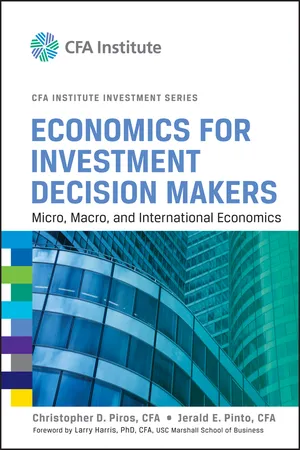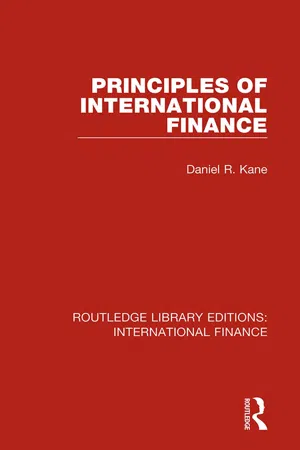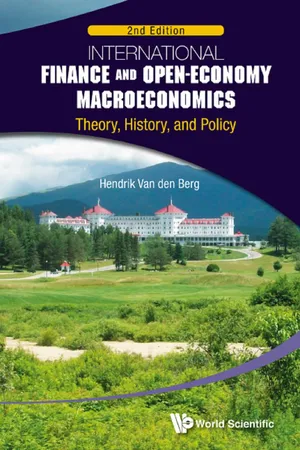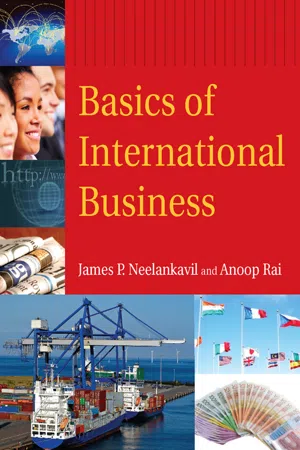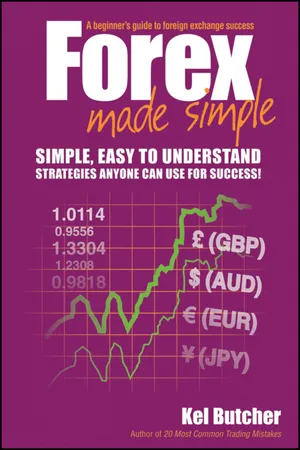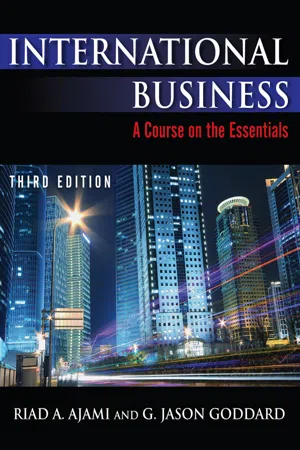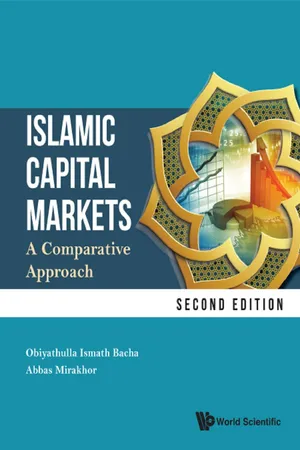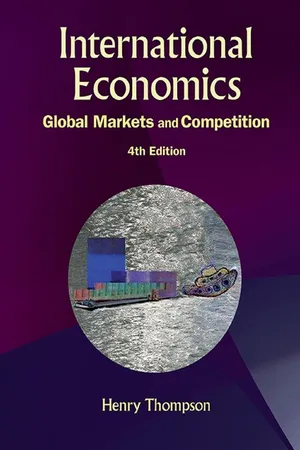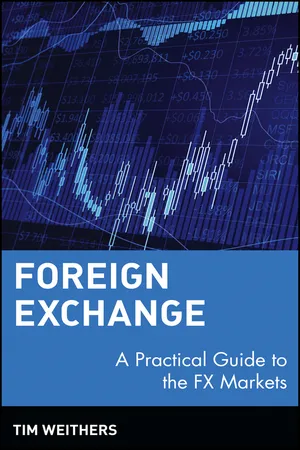Economics
Foreign Exchange Market
The foreign exchange market is where currencies are traded, allowing businesses and individuals to buy, sell, and speculate on different currencies. It is a decentralized global marketplace that determines the exchange rate for currencies. The foreign exchange market plays a crucial role in facilitating international trade and investment.
Written by Perlego with AI-assistance
Related key terms
Related key terms
1 of 4
Related key terms
1 of 3
10 Key excerpts on "Foreign Exchange Market"
- eBook - ePub
Economics for Investment Decision Makers
Micro, Macro, and International Economics
- Christopher D. Piros, Jerald E. Pinto(Authors)
- 2013(Publication Date)
- Wiley(Publisher)
The FX market is also a truly global market that operates 24 hours a day, each business day. It involves market participants from every time zone connected through electronic communications networks that link players as large as multibillion-dollar investment funds and as small as individuals trading for their own accounts—all brought together in real time. International trade would be impossible without the trade in currencies that facilitates it, and so too would cross-border capital flows that connect all financial markets globally through the FX market.These factors make foreign exchange a key market for investors and market participants to understand. The world economy is increasingly transnational in nature, with both production processes and trade flows often determined more by global factors than by domestic considerations. Likewise, investment portfolio performance increasingly reflects global determinants because pricing in financial markets responds to the array of investment opportunities available worldwide, not just locally. All of these factors funnel through, and are reflected in, the Foreign Exchange Market. As investors shed their home bias and invest in foreign markets, the exchange rate—the price at which foreign-currency-denominated investments are valued in terms of the domestic currency—becomes an increasingly important determinant of portfolio performance.Even investors adhering to a purely domestic portfolio mandate are increasingly affected by what happens in the Foreign Exchange Market. Given the globalization of the world economy, most large companies depend heavily on their foreign operations (for example, by some estimates about 40 percent of S&P 500 index earnings are from outside the United States). Almost all companies are exposed to some degree of foreign competition, and the pricing for domestic assets—equities, bonds, real estate, and others—will also depend on demand from foreign investors. All of these various influences on investment performance reflect developments in the Foreign Exchange Market. - eBook - ePub
- Daniel R. Kane(Author)
- 2018(Publication Date)
- Routledge(Publisher)
Part OneThe Foreign Exchange Market and the Balance of Payments
The Foreign Exchange Market (Chapter 1 ) is the market in which foreign currencies are bought and sold. As such, it is an integral component of international finance.Currencies are transacted to finance international trade and to facilitate international capital flows, but their conversion involves uncertainty. This creates risk which can either be eliminated (to minimise losses) or exploited (to maximise profits). The extent to which this risk is averted or accepted determines the use to which different types of foreign exchange rates and trading techniques are put. These are examined in Chapter 2 .Both trade and capital flows are recorded in the balance of payments, which is a systematic record of a country’s international transactions. The balance of payments, which is the subject of Chapter 3 , indicates whether a country is in external equilibrium or disequilibrium and the extent to which corrective policies, if any, should be implemented.Passage contains an image
1The Foreign Exchange MarketThe Foreign Exchange Market is:A market for the purchase and sale of foreign currencies (foreign exchange).It has no single physical location, but exists where and when there is a need to transact foreign currencies. Markets are principally found in leading financial centres such as London and New York and consist of market-makers, who are prepared to deal in foreign currencies. These market-makers comprise banks and brokers who are prepared to buy and sell foreign currencies from other banks, brokers, corporations, the general public and even governments.The price at which currencies are transacted is the foreign exchange rate, which is:The price of one currency expressed in terms of another.It indicates the number of units of foreign currency which buyers and sellers are prepared to exchange for units of domestic or other foreign currency. More specifically, the exchange rate can be expressed as the number of units of domestic currency which buyers and sellers are prepared to exchange for one unit of foreign currency. For example, if one pound sterling trades for two US dollars, the exchange rate from a UK perspective would be 50 pence per dollar (£0.50/$) and from a US perspective, two dollars per pound ($2/£). - eBook - ePub
International Finance and Open-Economy Macroeconomics
Theory, History, and Policy
- Hendrik Van den Berg(Author)
- 2016(Publication Date)
- WSPC(Publisher)
Part II
The Foreign Exchange Market
Passage contains an image
Chapter 3
The Foreign Exchange Market
The puzzling thing is that despite the obvious gain from the use of one money, it appears to be quite difficult to introduce one money in the international economy which will be acceptable to everyone.(Paul De Grauwe, 1989, p. 1)If you have traveled overseas, you are already familiar with exchange rates, the prices at which one country’s money is exchanged for another country’s money. In your travels, you were probably intrigued by the different currencies in countries you traveled to, viewing it as part of the “international experience”. Importers, exporters, and international investors generally do not view the coexistence of many different currencies throughout the world as a positive experience, however. They are more likely to see the many different moneys as a complication that adds to the cost of international transactions. There is some evidence that suggests that there would be more international trade and international investment if importers, exporters, and investors did not face the cost of having to exchange currencies every time they exchanged products or assets across borders.Foreign Exchange Markets are one of the distinguishing characteristics of the global economy. It is difficult to avoid the Foreign Exchange Markets when conducting international business. One way would be to avoid dealing with foreigners, but in today’s global environment that would severely limit business opportunities. Another way to eliminate the need for dealing with Foreign Exchange Markets would be for governments to abandon their national moneys for a single world currency. Despite some recent efforts to move in that direction, as in the case of the European countries who, after 2012 jointly adopted the euro as their shared money, most governments are not yet willing to surrender their national currencies and adopt an international currency. The global economy will in all likelihood have multiple currencies for the foreseeable future, and cross-border transactions will continue to require the exchange of currencies. - eBook - ePub
- James P. Neelankavil, Anoop Rai(Authors)
- 2014(Publication Date)
- Routledge(Publisher)
10 The Foreign Exchange MarketThe currency depreciation that we have experienced of late should eventually help to contain our current account deficit as foreign producers export less to the United States. On the other side of the ledger, the current account should improve as U.S. firms find the export market more receptive.—Alan Greenspan 1LEARNING OBJECTIVES
• To understand the role of foreign currencies in international trade• To comprehend the historical use of money and foreign exchange as a medium of exchange• To appreciate the growth of the Foreign Exchange Market into the largest financial market in the world• To examine the factors that affect foreign exchange rates• To understand the importance of Foreign Exchange Markets to multinational corporationsIf goods are purchased by a citizen of one country, with one currency, from a citizen of another country, with a different currency, the buyer in most cases prefers to make the payment in his or her own currency. This requires an exchange of currencies from that of the buyer to that of the seller. The purchase or sale of any goods from a citizen of one country to a citizen of another will always result in two simultaneous transactions:1. Physical exchange of the commodity2. Purchase or sale of a foreign currencyThe purchase or sale of the foreign currency affects only one of the parties in the exchange. If an American importer purchases US$100,000 worth of goods from a Japanese manufacturer and the invoice is billed in Japanese yen, the burden falls on the American importer to purchase Japanese yen to complete the transaction. If the contract is invoiced in U.S. dollars, the Japanese seller is responsible for converting the American dollars that were received into Japanese yen to complete the transaction. The party that has to convert the currency takes the risk that the exchange rate on that date of conversion is favorable to that party. - eBook - ePub
Forex Made Simple
A Beginner's Guide to Foreign Exchange Success
- Kel Butcher(Author)
- 2011(Publication Date)
- Wiley(Publisher)
Chapter 3: The Foreign Exchange Markets and major participantsWe need to understand who the major players in these markets are and the types of forex markets available. Forex market participantsNow that we have an insight into the major currencies and their economies, and the important role that central banks play within an economy and the foreign exchange, or forex, markets, we now need to deepen our understanding of the forex market before we begin forex trading.Tip The foreign exchange, or forex, market is divided into levels of access that are determined by the size of the line, or amount of money, being traded in each transaction. The inter-bank marketAs well as the central banks and their role in and influence on the global Foreign Exchange Market, many other participants are involved in the trading of foreign exchange. It is important to know who these other players are, where they fit in the market and the roles they play within the foreign exchange market.After the central banks, the large global commercial banks and financial institutions are the major participants in the forex market, and together they form the inter-bank market. While central bank operations in the market may be sporadic, the large commercial banks are actively involved in foreign exchange trading every day. Their trading activities add massive liquidity and volume to the market daily and are the main cause of price movement in the markets. Major international banks deal either directly with each other or through two main electronic platforms, EBS and Reuters, which offer trading in the major currency pairs. The banks regularly undertake trades worth billions of dollars on behalf of clients or, more commonly, speculateing on their own accounts. They are responsible for the majority of forex trading volume.The inter-bank market is an unregulated and decentralised wholesale market that works around the world and around the clock. These banks effectively act as market makers in the spot forex market (discussed later in this chapter), as they are constantly quoting buy and sell prices in anticipation of movements in currency prices. - eBook - ePub
International Business
Theory and Practice
- Riad Ajami, Jason G Goddard(Authors)
- 2014(Publication Date)
- Routledge(Publisher)
HAPTER 5Foreign Exchange Markets“Two and two are four, and five will get you ten if you know how to work it.” —Mae WestCHAPTER OBJECTIVES This chapter will:• Suggest the underlying need for Foreign Exchange Markets• Introduce the terms and definitions used in the Foreign Exchange Markets• Describe the structure and operations of the Foreign Exchange Markets• Present the mathematical formulas used to compare currency movements in the Foreign Exchange Markets• Discuss common techniques used to manage currency risk and exposure• Explain the need for and problems associated with forecasting foreign exchange ratesBACKGROUND
Nearly all international business activity requires the transfer of money from one country to another. Trade transactions must be settled in monetary terms: Buyers in one country pay suppliers in another. Repatriation of dividends, profits, and royalties from overseas investments, contributions of equity and other kinds of financial dealings from such investments also involve the transfer of funds across national borders. The transfer of funds poses problems quite different from those associated with the transfer of goods and services across national borders. Buyers and sellers are willing to accept and use goods and services from other countries quite routinely. For example, US consumers are content to drive Japanese cars, such as Toyotas and Hondas, while the Japanese are quite willing to use US operating systems or other high-tech products.This internationalization that applies to product usage is not found when it comes to accepting the currency of another country, however. While the US importer is happy to receive Japanese products and the Japanese importer is glad to accept US products, neither is normally in a position to accept the other’s currency. A US importer usually has to pay a Japanese exporter in Japanese yen, while a US exporter will generally want to be paid in US dollars. This is quite logical, since each country has its own currency, which is legal tender within its borders, and exporters are likely to prefer the currency that they can use at home for meeting costs and taking profits. - eBook - ePub
Islamic Capital Markets
A Comparative Approach
- Obiyathulla Ismath Bacha, Abbas Mirakhor(Authors)
- 2019(Publication Date)
- WSPC(Publisher)
Chapter 13EXCHANGE RATES AND THE Foreign Exchange MarketTopics in this Chapter13.1.Introduction 13.2.What is an Exchange Rate? 13.3.Exchange Rate Risk 13.4.The Foreign Exchange Market 13.5.Foreign Exchange Market Players 13.6.Spot and Forward Markets 13.7.Bid–Ask Spreads 13.8.The Forward Market for Exchange Rates 13.9.Rates13.10.Forward versus Spot Rates 13.11.Forward Market Players 13.12.Cross 13.13.Nominal versus Real Exchange Rates13.14.Shariah -Compliant Techniques for Managing Currency ExposureChapter ObjectiveThis chapter is designed to provide an overview of Foreign Exchange Markets, its activities, and products. The chapter discusses what exchange rates are, how they are quoted, and how changes are measured. Exchange rate exposure and its management are examined in depth. The chapter concludes with an examination of Shari’ah -compliant techniques for managing currency exposure. On completing the chapter, you should have a good understanding of how Foreign Exchange Markets work and of the Shari’ah -compliant alternatives now available.13.1.IntroductionThe foreign exchange (forex) market is an important part of any nation’s capital market. Depending on how one looks at it, one could either consider the Foreign Exchange Market as a component of the capital market or as a link between domestic capital markets with global capital markets. Either way, the forex market can be a key source of liquidity for a domestic capital market. Actions of participants in the forex can either increase liquidity in a domestic capital market through capital inflows or drain liquidity through capital outflows.The proper functioning of a domestic capital market and its well-being can depend, to a large extent, on equilibrium in the Foreign Exchange Market and the national currency’s exchange rate (see Figure 13.1 - eBook - ePub
International Economics
Global Markets and Competition
- Henry Thompson(Author)
- 2017(Publication Date)
- WSPC(Publisher)
Uncertainty about the exchange rate increases the risk of international transactions. A mechanism for avoiding exchange risk is the forward exchange market where a contract is signed to buy or sell foreign currency at some future date at a set rate.A. THE Foreign Exchange Market
The FX market is based on the supply and demand of foreign exchange. Fundamental relationships involving exchange rates include •The exchange rate link to prices of imports and exports•The response of the BOT to depreciation or appreciationThe FX Market
An importer trades domestic currency for foreign currency on the foreign exchange FX market. Consider a US importer buying Japanese products. The importer can go through a bank to buy the yen to transfer to the bank of the Japanese exporter. Banks and import agencies specialize in currency transactions as well as import restrictions and customs paperwork.Suppose the exchange rate of the yen is $0.008 in the FX market. As with any commodity, price is expressed in home currency. Apples cost $1/pound and Japanese currency $0.008 per yen. One dollar trades for 1/.008 = 125 yen. If the price of M is 625 yen in dollars is $0.008 × 625 = $5. The decision of whether to import is based partly on the FX rate.If the price of the dollar rises to yen/$ = 200 the dollar price of M falls to 625/200 = $3.13. An appreciating currency lower the price of imports and increases the quantity demanded. If imports are elastic, import spending rises as does the quantity of foreign currency demanded.This inverse relationship between $/yen and the quantity of yen demanded is illustrated by the demand for yen in Figure 11.2 . The rise in yen/$ from 125 to 200 equals a fall in $/yen on the vertical axis from 0.008 to 0.005. The quantity of yen demanded rises from 20 to 30 trillion.On the supply side, Japanese importers buying US exports sell yen in the FX market. If the price of business services is $10/S - eBook - ePub
Foreign Exchange
A Practical Guide to the FX Markets
- Tim Weithers(Author)
- 2011(Publication Date)
- Wiley(Publisher)
Banks, whether commercial, investment, central, or supranational, are intimately involved in the markets for foreign exchange. Commercial banks are sometimes asked to assist their local clients with their foreign exchange risk. Investment banks tend to be more active, but this depends on the reason for their FX trading (facilitating client transactions, hedging their business exposures, cross-border issuance, international mergers and acquisitions, and even proprietary trading). Central bank activity ranges from the management of their foreign reserves through active FX market intervention.Of course, if exchange rates never moved (i.e., if they were fixed), then much of the trading activity (whether hedging or implementing views on the market) would cease. Having spelled out the economic rationale for many of the trades undertaken by the FX market participants, we now consider the possible implications of fixed exchange rates.FIXED VERSUS FLOATING EXCHANGE RATES
Economists have long debated the advantages, disadvantages, virtues, shortcomings, merits, costs, and benefits of a fixed exchange rate system versus a floating exchange rate system. “Does the choice of exchange rate regime matter? Few questions in international economics have sparked as much debate and yielded as little consensus.”6Fixed Exchange Rates
The attraction of fixed exchange rates is the presumed stability they provide for those engaging in international transactions. If USD|JPY is fixed at 120.00, then a U.S. software firm can enter into trade agreements in which their product will sell for JPY 6,000 in Japan—comfortable that they will receive USD 50 as a result of that sale. Similarly, a Japanese automobile manufacturer might sleep better knowing that their cars, selling in the United States for USD 20,000, will appear on the bottom line as JPY 2,400,000.Sounds good.The real problem, though, with fixed exchange rates is that someone must keep them fixed. If the institutions charged with maintaining the exchange rate (which, if it indeed requires active support, is obviously not set at the market clearing rate) are either unable or unwilling to maintain the peg, then there are potentially large impacts associated with formal devaluation (reduction in a currency’s value) or revaluation (appreciation of a currency’s value). As with agricultural price supports, the minimum wage and rent control, any interference with market prices creates inefficiencies, distortions, and influences behavior in a way that may not be desirable. - eBook - ePub
- Dr Catherine Schenk(Author)
- 2001(Publication Date)
- Routledge(Publisher)
4 Foreign Exchange Markets
As Jao has noted, ‘the Foreign Exchange Market is widely regarded as an extremely important criterion for evaluating an IFC’.1 This chapter will show that Hong Kong’s free market in foreign exchange was the foundation of its role as a regional and international financial centre in the 1950s. By 1957, the Far Eastern Economic Review proudly recorded thatHongkong’s free exchange market has attracted many operators from foreign countries who have found every reason to be satisfied with the bankers and financiers established here…Several Chinese banks, erstwhile known as ‘native banks’, have remarkably increased their international connections and are today able of serving the needs of a global free market and also those markets where controls of some sort prevail…Possibilities of Hongkong/Far Eastern and Hongkong/Europe free exchange transactions offer many opportunities as enterprising Chinese bankers as well as European financiers are exploring them ever on the look-out for better international service and additional profits.2The importance of the post-war global economic environment to Hong Kong’s development as an international financial centre is clearly demonstrated in the case of the Foreign Exchange Markets. Hong Kong’s position between the sterling area and the dollar area allowed the territory to offer to investors and traders financial services unrivalled anywhere else in the world. As will be discussed in greater detail below, because of exchange controls existing elsewhere the free market facilitated securities trading, and the settlement of sterling debts among people not resident in Hong Kong.3Structure and operation of the dollar market
After World War Two, Britain restricted the convertibility of sterling with the cooperation of a group of Commonwealth and other countries known as the sterling area. The members of the sterling area enjoyed unrestricted capital flows and current transactions with the UK in return for operating a common exchange control against the rest of the world.4 Hong Kong was one of two gaps in this control.5
Index pages curate the most relevant extracts from our library of academic textbooks. They’ve been created using an in-house natural language model (NLM), each adding context and meaning to key research topics.
Explore more topic indexes
Explore more topic indexes
1 of 6
Explore more topic indexes
1 of 4
